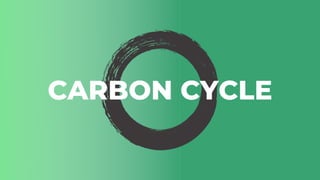
Carbon cycle
- 1. CARBON CYCLE
- 2. Carbon is the chemical element of atomic number 6, a nonmetal which has two main forms (diamond and graphite) and which also occurs in impure form in charcoal, soot, and coal.
- 3. Carbon is represented by the symbol ‘C’ and is the fourth most abundant element in our solar system, only surpassed by hydrogen,helium and oxygen
- 4. Plants and trees are made up of a large proportion of carbon, hence their importance to the Carbon cycle. The chemical composition of wood differs from various species, sizes and locations of the organic material.
- 5. Carbon is the foundation of all life on Earth, required to form complex molecules like proteins and DNA. This element is also found in our atmosphere in the form of carbon dioxide (CO2). Carbon helps to regulate the Earth’s temperature, makes all life possible and is a key ingredient in the food that sustains us.
- 6. Overall, wood has an elemental composition of about 50% carbon, 44% oxygen, 6% hydrogen, and trace amounts of several other elements (mainly calcium, potassium, sodium, magnesium, iron, and manganese) . Trees absorb carbon dioxide and release oxygen in the process of photosynthesis.
- 7. Carbon is an important component of our atmosphere as it is both naturally cycled and unnaturally emitted. It is released naturally through respiration, soil upheaval, volcanic eruptions and its natural cycles within the earth’s atmosphere. Although, the burning of fossil fuels (oil, natural gas, and coal), solid waste, trees and wood products, and chemical processes are adding an unnatural amount of C02 into the carbon cycle.
- 8. The carbon cycle describes the process in which carbon atoms continually travel from the atmosphere to the Earth and then back into the atmosphere. Since our planet and its atmosphere form a closed environment, the amount of carbon in this system does not change naturally. The carbon is constantly fluctuating depending on the cycles within earths system. Carbon is released back into the atmosphere when organisms die, volcanoes erupt, fires blaze, fossil fuels are burned, and through a variety of other mechanisms. On Earth, most carbon is stored in rocks and sediments, while the rest is located in the ocean, atmosphere, and in living organisms. These are the reservoirs, or sinks, through which carbon cycles. In the case of the ocean, carbon is continually exchanged between the ocean’s surface waters and the atmosphere, or is stored for long periods of time in the ocean depths.
- 10. Humans play a major role in the carbon cycle through activities such as the burning of fossil fuels or land development. The current influence of human alteration to the environment is called the Anthropocene, which correlates to recent human impact. Humanity is drastically altering the earth's climate and are disrupting the climatic stability of the present geological era of the Holocene. Humans are adding excessive additional carbon into the atmosphere through various systemic modern impacts that have been exacerbated since the industrial revolution. We have surpassed 415 parts per million of carbon dioxide in the atmosphere, which as altered the chief regulating compound of our climate. We have caused climatic irregularities that are surpassing previous records and even previous recorded mass extinctions. It is relevant to say that humanity is walking on thin ice.
- 12. Carbon monoxide (CO) and carbon dioxide (CO2) are quite similar. They’re both odourless, colourless gasses with similar names, which is why they’re so often confused with one another. Another quality they share is they can both be deadly if they exceed certain levels. The difference between the compound is the level of oxygen particles that it binds to. Carbon monoxide binds to one oxygen particle and Carbon dioxide binds to two oxygen particles. The atomic mass of carbon (c) is 12.001 and the atomic mass of oxygen is 16, so the atomic mass of C02 = 44. C
- 14. Carbon dioxide is one-part carbon and two parts oxygen. This is a natural gas in the atmosphere that is a by-product of our existence on Earth – specifically, human and animal respiration, the combustion of fossil fuels and wood, fermentation, and other causes. While carbon dioxide is a naturally-occurring gas, it can be harmful in highly concentrated amounts. As it currently stands, the average CO2 level on the planet is 415 ppm (parts per million). Because of its natural characteristics, CO2 poisoning is quite rare. Internal combustion engines or leaking CO2 tanks do have the ability to subject individuals to dangerously high levels of CO2, so it doesn’t hurt to know the signs and symptoms, which can include dizziness, fatigue, and headaches.
- 16. Carbon dioxide is the most prominent of the greenhouse gases. Sources of atmospheric CO2 include volcanoes, the combustion and decay of organic matter, respiration by aerobic (oxygen-using) organisms, and the burning of fossil fuels, clearing of land, and production of cement by humans. These sources are balanced, on average, by a set of physical, chemical, or biological processes, called "sinks," that tend to remove CO2 from the atmosphere. Plant life, which takes up CO2 during the process of photosynthesis, is an important natural sink. In the oceans, marine life can absorb dissolved CO2, and some marine organisms even use CO2 to build skeletons and other structures made of calcium carbonate (CaCO3).